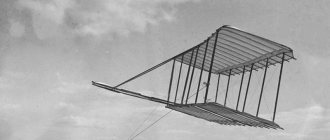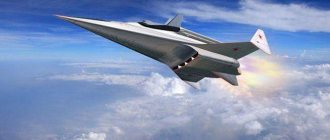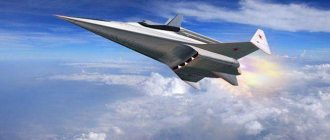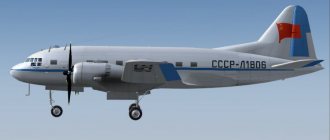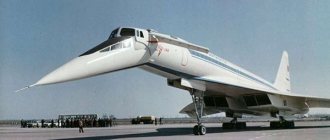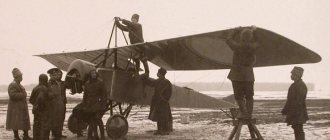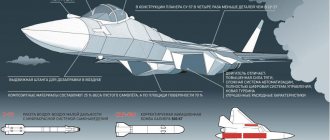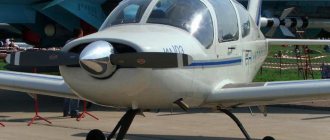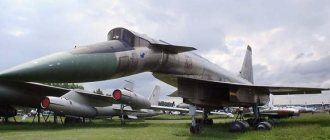History of the aircraft
The development of the An-30 aircraft began in mid-1964 by order of the government, with the Main Directorate of the Civil Air Fleet of the USSR acting as the customer. The Antonov Design Bureau was faced with the task of developing a design for a new machine for aerial photography based on the outdated An-24, which was used for similar purposes.
AN-24 aircraft
Initially, it was assumed that two variations of the aircraft would be created: civil and military. Later, this idea was abandoned, deciding to release basic modifications 30A and 30B, which differ in the set of photographic equipment and the presence of additional equipment.
Development was carried out at a fast pace. Already by 1965, the OKB submitted for evaluation a preliminary design with a finished layout, called the An-24FK. According to the documents, the main difference between the new car and the old An-24 was to be the redesigned nose section.
An-24 aircraft in 1964.
It expanded and received a glassed-in navigator's cabin, while losing the radar system previously installed there. The cockpit was moved a little higher, and a fairing appeared under the fuselage. The aircraft was also equipped with additional fuel tanks, allowing the An-30 to remain in the air longer.
At the beginning of 1967, the designers presented the first prototype of the 30A variation, manufactured at the Taganrog plant. Already in August the plane took off and performed a short flight. In total, it carried out more than 30 test flights. By 1968, the 30B model had been tested and flown 13 times. Factory tests were completed by July, after which the aircraft was handed over for government inspection. In February 1970, experts from the State Research Institute of Civil Aviation began testing the An-30 variation 30A.
Test results were mixed. The aircraft was positively noted, confirming its great advantages over previous models of this class. The installed equipment and capabilities related to aerial photography were also highly appreciated. However, the An-30 had a serious flaw. It was a lack of fuel.
According to experts, it could be increased by 10–20%. There were also minor comments regarding the instruments and crew workplaces. Nevertheless, the aircraft was recommended for serial production with subsequent performance of small and medium-scale aerial photography for civil or military purposes.
In 1971, the design bureau began producing the first mass samples. An aircraft plant in Kyiv was chosen for production. A total of 124 aircraft rolled off the production line, some of which were intended for export. The An-30 was first presented at international exhibitions in 1975 in Paris. Later, the designers worked on several modifications that expanded the capabilities of the aircraft.
Operators[edit]
Military operators of An-30
An-30 Bulgarian Air Force
An-30 aircraft
Former Soviet Antonov An-30 at the Ukrainian State Aviation Museum.JPG
Military operators[edit]
Bulgaria
- Bulgarian Air Force - one (as of 2022) [17] [18]
Romania
- Romanian Air Force - three in operation since 1976; currently two [19] (as of 2022) [17]
Russia
- Russian Air Force
Ukraine
- Ukrainian Air Force - three (as of 2022) [17]
Former military operators[edit]
Afghanistan
- The Afghan Air Force received the An-30 in 1985.
Cuba
- Cuban Air Force
Czech
- The Czech Air Force retired its An-30 in 2003.
Czechoslovakia
- Czechoslovak Air Force
Mongolia
- Mongolian Air Force
People's Republic of China
- People's Liberation Army Air Force
Soviet Union
- Soviet Air Force
Vietnam
- Vietnam People's Air Force
Civilian operators[edit]
Congo
- Aero-Fret
Former civilian operators[edit]
People's Republic of China
- CAAC Airlines
Mongolia
- MIAT Mongolian Airlines
Russia
- Moscow Airlines
- Lukiaviatrans
- Myachkovo Air Services
- Novosibirsk Air Enterprise
- Flight: airlines
- Center for Practical Geodynamics
Ukraine
- ARP 410 Airlines
- National Airlines of Ukraine
Vietnam
- Vietnam Air Service Company
Sudan
Technical and flight characteristics of the An-30
The basic An-30 is designed for a crew of 7 people. It has a length of 24.26 m, its height is 8.32 m. The wing has a span of 29.2 m with an area of 74.98 m². An empty plane without equipment weighs 15.59 tons. Its maximum take-off and landing weight is limited to 23 tons. Photographic equipment - up to 650 kg.
On board the An-30 there are two AI-24VT engines with a power of 2820 hp. With. and one RU-19A-300 with a thrust of 800 kgf. The plane can accelerate to 540 km/h, its cruising speed is 435 km/h. The practical ceiling is limited to an altitude of 8300 m. The flight range reaches 1240 km; during ferrying, the An-30 is capable of covering 2630 km. Average fuel consumption is 855 kg/h. During takeoff, a run of 770 m will be required. For landing, a run of up to 640 m is required.
Without repairs, the aircraft can fly up to 4,000 hours. The total assigned resource for the An-30 is 20,000 hours with 10,000 sorties. A technical inspection must be carried out once every 300 flight hours.
Aircraft design features
When building the An-30 aircraft, the design of a cantilever monoplane with a vertical tail was chosen. The high-mounted trapezoidal wing consists of a center section with consoles. Slotted flaps are located in its middle; along the edges there are dedicated zones with ailerons, which are equipped with special compensators with trimmers.
The tail unit is single-finned and cantilever. The An-30's landing gear is of a three-legged type and can be retracted during flight into special niches. The leading strut is installed in the nose of the aircraft. The two main ones are located under the wing in the area of the power plant.
AI-24 turboprop engines are installed in special nacelles, which are mounted inside the center section. They are equipped with propellers with four blades of the AB-72 model. The power plant is started through an independent turbogenerator TG-16. There are also two electric generators on board that provide the aircraft with electricity.
In the event of an emergency, 12CAM batteries can be used. Fuel tanks are located inside the wing. Each one supplies fuel to a specific engine. An additional tank is mounted in the center section, capable of holding another 1000 liters. All of them can be assembled into a single unit in case of failures through the use of a ring tap.
The aircraft is equipped with two anti-icing systems. One is of the air-thermal type and is responsible for protecting the wing with engines. The second is electric. It prevents ice from forming on propellers, cockpit windshields, batteries and pressure receivers. There is also an oxygen system on board, designed to provide air for seven people. It includes special KP-24M devices, masks, cylinders and pressure gauges.
The hydraulic system is responsible for folding the landing gear, controlling the flaps, braking and turning the wheels. It is also used to launch other aircraft elements. For example, windshield wipers. The main hydraulic system operates from hydraulic pumps located on the power unit. The emergency one, installed in case of damage to the first one, performs its functions using a pumping station.
Design[edit]
Lukaviatrans An-30A
The Antonov An-30 is a derivative of the An-24, it is fitted with a completely new fuselage at the front of frame 11. The forward fuselage has wide glazing, reminiscent of the Boeing B-29. The new bow houses the navigator and precision navigation equipment, including an optical sight to ensure accurate aerial photography. [3] To ensure accurate and repeatable surveillance flights, the An-30's standard equipment included computer flight path control technology. [7] This additional equipment replaced the radar on the An-24. The placement of new navigation equipment required raising the cockpit by 41 cm compared to the An-24 [3], which gave the aircraft its other main feature - the protrusion on which the cockpit was located.
The radio operator and flight engineer sat in the first cabin aft and below the flight deck. The mission equipment was located further aft, in a cabin with five windows in the floor. The window of each cell could be covered with covers to protect the glass panels. The covers were located in special fairings protruding from the underside of the fuselage. For typical aerial photography, there were four or five cameras on board. Three cameras were mounted vertically for mapping. The remaining two cameras were aimed at 28° on each side of the aircraft for angled photography. In the same fuselage compartment there were workstations for two operators and a crew rest area. [8]
The aircraft's cameras could be used from 2,000 to 7,000 m (6,500 to 23,000 ft) and the resulting photographs had a scale of 1:200,000 to 1:15,000,000. [2] The aircraft was equipped with four or five cameras.
The An-30 was equipped with two Ivchenko AI-24 VT turboprop engines with a take-off power of 2,820 hp. [2]
An-30 cockpit
The An-30 aircraft has separate cabins for pilots, navigators and aerial photography. They all received advanced equipment to perform their tasks. The pilots have classic steering wheels with other aircraft controls. It itself is raised a little higher to improve visibility.
The navigator's cabin is located lower and is equipped with a large canopy that provides good visibility. Using visibility and navigation instruments from here, you can set the correct flight direction, estimate the location in bad weather conditions, and also ensure high-quality shooting.
In the middle compartment there is a space allocated for it. The aerial camera room is sealed like other aircraft cabins. There are five special hatches with glass installed inside through which you can carry it through. They are blown with warm air to prevent icing and are closed with lids. In the same room there are rest areas for crew members, a kitchen area and a bathroom.
Links[edit]
- Photo gallery of the An-30 aircraft on Pravda.Ru
Notes[edit]
- ↑
A prototype aircraft (a converted An-24, designated An-24FK) first flew on August 21, 1967. The first production An-30 made its first flight in 1974. - ^ abcdef Gordon, Komissarov, Komissarov 2003, p. 75.
- ^ abc Gordon, Komissarov and Komissarov 2003, p. 73.
- Gunston, Bill (1995). Encyclopedia of Russian aircraft for 1875-1995
. Osprey Aerospace. ISBN 978-1-85532-405-3. - "✈ russianplanes.net ✈ our aviation". Archived from the original on November 9, 2015. Retrieved November 1, 2015.
- "Antonov An-30 Aerial Car Aerial Cartography Aircraft - Air Force Technology". Air Force Technologies
.
Kable Intelligence LTD. Archived from the original on October 10, 2015. Retrieved November 9, 2015. [ unreliable source?
] - Green, W (1976). The Observer's Book of Aircraft (25th ed.)
. Frederick Warne & Co. ISBN 978-0-7232-1553-0. - ↑
Gordon, Komissarov and Komissarov 2003, p. 74. - M. J. H. Taylor, ed. (1999). Brassey World Aircraft & Systems Catalog 1999/2000 edition
. Brassey. ISBN 978-1-85753-245-6. - "Ukraine crisis: Biden says Russia must 'take action' - BBC News". BBC News
. 2014-04-22. Archived from the original on January 4, 2022. Retrieved June 21, 2022. - “The reconnaissance plane was shot down over Slavyansk by the militia - TV Channel “Zvezda” .” Archived from the original on June 12, 2014. Retrieved June 8, 2014.
- "Another Russian plane tragedy". Archived from the original on 2012-06-21. Retrieved May 23, 2012.
- "Sudanese Defense Forces on Twitter". Twitter
. Retrieved October 3, 2022. - ↑
Gordon, Komissarov and Komissarov 2003, p. 77. - ↑
Gordon, Komissarov and Komissarov 2003, p. 80. - ^ ab Gordon, Komissarov and Komissarov 2003, p. 83.
- ^ abc Przeworski, Marcin (July 2022). "Transportowa Europa cz.II". Skrzydlata Polska
(in Polish). No. 7 (2453) / 2022. pp. 38–46. ISSN 0137-866X. - “Successfully flown an An-30 for use on the resource - Aviation - Pan.bg”. Archived from the original on August 18, 2016. Retrieved April 8, 2016.
- "Equipment of the Romanian Armed Forces". European Defense Equipment
. ArmedForces.co.uk. Archived from the original on December 28, 2012. Retrieved April 22, 2014. - J. W. R. Taylor, ed. (1988). Planes of the World Jane, 1988–89
. Jane Information Group. ISBN 978-0-7106-0867-3. - Gladniker, David. "An Incomplete Guide to Using an Airfoil". m-selig.ae.illinois.edu
. Retrieved April 16, 2022.
https://russianplanes.net/planelist/Antonov/An-30
Bibliography[edit]
- Efim Gordon, Dmitry Komissarov and Sergei Komissarov (2003) Antonov's turboprop twins
. Hinckley, UK: Midland Publishing. ISBN 1-85780-153-9
Equipment
The An-30 received equipment for piloting and navigation, which is similar to the version from the An-24. It allows you to correctly assess the position of the aircraft and select the flight path. There is also an autopilot on board, which allows you to launch automatic control for high-quality shooting.
In later versions of the aircraft, an angle and ground speed meter were installed. Electronic equipment includes a new radio receiver, transmitter, station and intercom. There is also a radio altimeter with special compasses. Some modifications have an improved Lotus navigation system.
Among the equipment for aerial photography there are several types of cameras, including AFA41/7.5, AFA-54/40 and AFA 54/50. Also present is the N-55 stabilizer, RVTD-A radio altimeter and statoscope. Additional components include command instruments, an air exposure meter, and sights. In some modifications, the following are placed on board: an AFA-54/15 camera, a TAU-M stabilizer, and a special electronic meteorograph. Shooting is carried out at scales from 1 to 3000 to 1 to 200000 with different focal lengths. The photographs taken can be processed immediately in flight.
Which plane is better?
AN-30AN-24
b 1964 C. OEPED nya-49 ASHKYU ONYARYUBKEMYU GYUDYUVYU YANGDURE MU AYUGE OYUYAYUFHPYAYNTSN KUIMEPYU yuM-24 YAYULNKER DK YUSCHPNTNRNYAZELYKH YuM-24ty. yaYULNKER YANGDUBUKYA YANTSKYUYAMN onYARYUMNBKEMKHCH yal yayap ╧565-235 NR 6 KhChK 1964 Ts. X DNAFEM ASHK GYULEMKHRE B SCHRNI PNKH kH-2th, xK-14ty X xK-14tyl.
oEPBNMYUVYUKEMN LYUHMY PUGPYUAYURSHBUKYUYAE B DBSU BYUPKHYUMRYUU: “u” DKЪ TSPYUFDUMYAYNI YUBHYUZHHH X “a” DKЪ bbya, NDMUYN ONGFE OPKHKH Y EDKHMNI YNLONMNBYE I PUGKKH VHLKH KHIE B YANYARYUBE TNRNNANPSDNBYUMKH YAOEZHYUOOYUPYURSPSH.
b 1965 Ts. ASHK GUYNMVEM SHYAYKHGMSHY OPNEIR, X I 12 OH 16 KhChK 1965 Ts. mu NOSHRMNL OPNKHGBNDYARBE nya Y KERS 1967 Ts. B BYUPHYUMR yuM-24ty (KhGDEKHE “ty”) OND PSYNBNDYARBNL BEDSYETSN YNMYARPSYRNPU b. b. bNKYNBU ASHK OEPENANPSDNBYUM YAEPHIMSHI YuM-24 (GYUBNDYAYNI ╧57302003).
YuM-24th NRKHVYUKYA NR OYUYAYUFKHPYAYNTSN YAYULNKERYU B OEPBSCH NVEPEDE ONKMNYARECH KHGLEMEMMNI MNYANBNI VYUYARECH TCHGEKKFYU DN OOYUMTSNSRYU ╧11. EE PYYYAHPHKH H GYUYAREYKHKH DK SKSVIEMH NAGNPYU RSPLUMYU.
b MHFMEI VYUYARKH TCHGEKKFYU LEFDS BOYUMTSNSRYULKH ╧╧21 - 30 ASHKKH NANPSDNBYUMSH ORRE GYUYAREIKEMMSHU TNRNACHINB, YU LEFDS BOYUMTSNSRYULKH ╧╧31 - 33 NANPSDNBYUKH METS EPLERKHVMSHY NRYAYE DK AKNYNB dhyaya-ty. хGLEMEMMHOL ONDBEPTSKNYAE NANPSDNBYUMKHE YYULNKERYU, pkya "schLAKELYU" X OYUYAYUFHPYAYNE NANPSDNBYUMKHE DELNMMRKHPNBUKH, B ZHEMRPNOKYUME SYARYUMNBHKH DNONKMKHREKEMSHE RNOKHBMSHE AYUYKH, S YARYUMNBHKH ONDTCHGEKFMSHI NAREYUREKE, AYUTSYUFMSCH DBPE YAMKKH, YU EE OPNEL TSEPLERHVMN GYUHKH. schYHOYUF REOEPE YANYARNK KH YAELH VEKNBEY: DBSU KERVKHYNB, LRSPLUMYU-YUSCHPNTNRNYAZELYHYU, PYUDHYARYU, ANPRLEUUMHYU KH DBSU NOEPYURNPNB.
oEPBSHI ONKER yuM-24th YANYARNKYAJ 21 YUBTSSYARYU 1967 Ts. ERMN-HYAOSHRYUREKEMNI AYUGE nya n. y. yuMRNMNBYU B TSNYARNLEKE (BAKKHGH yHEBYU) X MU NDMNL XG YAPEDMEYUGHYURYAYHU YUSCHPNDPNLNB.
I DEYUAP 1968 Ts. ON YAEMRJAPE 1969 Ts. OPNYKH TSNYASDYUPYARBEMMSHE KERMSHE HYAOSHRYUMKH B BYUPHYUMRE “a”. bYAETSN BSHONKMEMN 45 ONKERNB, KH MHU ON BYUPHYUMRS "yu" - 32 ONKERYU, ON BYUPHYUMRS "a" - 13 ONKERNB. mu YAYULNKERE KERUKKH KERVKHYKH-HYAOSHRYUREKH h.m. ySPKHM, h.m. YERNB, a.b. YaREOYUMNB, b.u. GYUKCHANBAYKHI, LRSPLUM-HYAOSHRYUREKE ts.m. tsSLEMCHY, ANPRPYUDHYAR ch.ya. YASLMSHY, BEDSYKHI KHMFEMEP a.l. CHYNB.
YuM-24th SYAOEMN OPNYEK HYAOSHRYUMKH, KH B TEBPYUKE 1970 Ts. 7 YOOPEK ON 17 KhChM 1970 Ts. BEDSYKHI KHMFEMEP a.l. eLEKEMNB).
ON PEGSKERYURYUL HYAOSHRYUMKHI ASHKN NRLEVEMN, VRN YAYULNKER HLEER GMYUVHREKEMSHE OPEHLSYYARBU OEPED xK-14ty X tyl. b VYUYARMNYARKH, LNFER BSHONKM'RE YUSCHPNTNRNYAZELYKH B TsNPMSHU X BSHIANYNTsNPMSHU PUINMYUU, HLEER ANKEE BSHYANISCH OPNKHGBNDHREKEMNYARE BYAKEDYARBHE ANKEYNI YAYNPNYARKH ONKERYU, SKSVIEMM SHE SYAKNBKH PUANRSH SHCHYHOYUFYU YAVER PUGLEYEMKH ETSN B TSEPLERKHGKHPNBUMMNI YYUAKHME KH NYNAEMMN LRSPLUMYU-YUSCHPNTNRNYAZELYHYU, PUANVEEE LEYARN YNRNPNTSN REOEPE PUYAONKYUTSYUK NYAE B GYUYAREIKEMNI MNYANBNI VYUYARKH YYULNKERYU. MUKHVKHE DNOKEPNBAYNTSN KHGLEPHREK STSKYU YAMNYAYU X OSREBNI YAYNPNYARKH NAEYAOEVKHBUKN ANKEE RNVMNE YAYULNKERNBNFDEMKHE.
th YASYYYYARBEMMSHL MEDNYARYURYUL GYUYUGVHYH NRMEYAKH LYUKSHI, ON HU LMEMKHCH, ONKMSHI GYUOYUYA RNOXBYU - 4960 YTS (RPEAANBYUMKHE SBEKHVKHRE ETSN DN 5500 - 6000 YTS ONDMKHLYUKNYA E E YE MU ShchRYuOE PUYAYALNRPEMH LYUYERYU), Yu NYARYUKEMSHE GYULEVYUMH YYUYUKHYAE YAOJHYUKEMNI X YUSCHPNTNRNYAZELNVMNI YOOYUPYURSPSH X NANPSDNBYUMH PUANVKHU LEYAR (MYUVHMYU NR MEDN YARURNVMNI BEMRHKJHHH RELMNI YNLMYURSH DK OPEGYUPYYYH YYUYAYAER X GYYYUMVHBYU NRYASRYARBHEL OOEOEKEMHZHSH MU PUANVEL LEYARE URSPLYUMYU).
YAKEDSER NRLERKHRE, VRN ANKEHMYARBN MNBNTsN YAOEZHNANPSDNBYUMKH, MUOPHLEP DNOKEPNBYAIKHI HGLEPHREKE dhya-ty, YUBRNLYUR OPNTsPYULLLMNTsN PYUGBNPNRYU yupo-2 B YNLOKEYRE I YUBRNOHKN RNL yuo-28k1t, YUSCHPNTNRNYAZELNVMNE NANPSDNBYUMHE X YUSCHPNTNRNLUREPHYUKSH OPNUNDHKH TSNYASDYUPYARBEMMSHE KERMSHE HYAOSHRYUMHYU MU-24th NDMNBPELEMMN I HYAOSHRYUMHYLH YU LNKERYU.
NAYYU NZHEMYU ASHKYU RYUNBYU - yuM-24th LNFER ASHR ASHRE PAINLEMDNBYUM DK OPNBEDEMH YAPEDME-H LEKYNLLUYARYUAMSHU YUSCHPNTNRNYZELNY B ONDPYUGDEKEMKHU ltsu X bbya.
oPH SVIYARKHH YNMYARPSYRNPNB nya ts. l. aEPKHEBU YYULNKER yuM-24ty ASHK GYUOSYEM B YAEPKHCH OND NANGMYUVEMHEL yuM-30
MU YHEBYAINL YUBHYUZHNMMMNL GYUBNDE B 1971 Ts. ASHKN ONYARPNEMN 115 LYUKHM, KH MHU 66 - B BYUPKHUMRE yuM-30yu DKЪ ltsu, 26 yuM-30a DKЪ bbya X 23 - MU SHYYAONPR (NMH ONYARYUBKKKHYAE B yutTSYUMKHYARYUM, anktsyuPhCH, bE ERMYUL, imp, ySAS, pSLSHMHCH, lNMTsNKHCH X vyap).
bYUPKHYUMRSH "yu" X "a" YAYULNKERYU yuM-30 NRKHVYUKHYAE RNKEIN MYUKHVHEL MU ANPRS BYUPKHYUMRYU "a" TNRNYUOOYUPYURNB yutu-54/50, TsKHPNYARYUAHKHGHPSCHYEI SYARYUMNBYKH RUS-L, PYUDH NBSHYANRNLEPYU pb-25yu, SHKEIRPNLERENPNTSPYUTYU KH PYUDKHNMYUBKHTSYUZHNMMNI YAKHYARELSH “KNRNYA”. b NYARYUKEMNL NANPSDNBYUMKHE ASHKN YUMYUKNTSKHVMN.
b UNDE SHYAOXYURYUZHKH VYUARE YAYULNKERNB NYAMYUARHKKH pkya “tsPNGYu l-30”. mu LYUKHMYU, SVIYARBNBUKHU B ANEBSHU DEIYARBKHU, SYARYUMYUBKHBYUKHYAE YNMREIMEPSH “BEEP” YAN 192 OHPNOYURPNMYULH NRYARPEKYU hy-KNBSYE, KHAN sb-26, BREAD ON 384 OHPNOYURPNMYU. b MYUVYUKE 1980-U MEYAINKEIN LYUHM ASHKN LNDKHTHZHHPNBUMN B BYUPHYUMR YuM-30l “LERENGYUYKHRYU”. LEYARN TNRNYUOOYUPYURSPSH MU MKHU GYUMKN NANPSDNBYUMKHE DK YAAPNYU PYUGLEYEMMNTSN B BNYAELH YNMREIMEPYUU (ON 130 YTS B YUFDNL) NDYU (“YASUNTSN KEDYU”), BSHGSHBYUCHYEI YURLNYATEPMSHE NYYUDYKH.
oEPBSHE yuM-30yu, ONYARSOKHBKHE B ltsu, BNKKH B YANYARYUB YAOEZHHYUKEMSHU YUBKHYUNRPJDNB, AYUGHPNBYUBKHYA B OSKYNBN OND KEMKHMTsPYUDNL KH B ONDLNYAYNBMNL lVYNBN. YaYULNKERSH SHYAOXYURKHPNBUKKHYAE NVEME KHMREMYAKHBMN, DNYARYURNVMN YAYUGYURE, VRN GYU OEPBSHE ORRE KER SHYAOXYURYUZHKH HLH ASHKN NRYAMRN ANKEE 28 LKM YL2 REPPHRNPHH yaya p. b 1975 C. yuM-30yu (BREAD TSNYAPETSKHsRPYUZHCH yayap-30030) DELNMYARPHPNBUKYA MU YUBKHYUYUKNME B kE-aSPFE.
b bbya YAYULNKERYULH YuM-30a BNNPSFHKH NRDEKEMSHE DUKEMEPYUGBEDSHBUREKEMSHE SHYAYYUDPHKEH (NDPYUSCH), DKHYAKNZHPNBYUMMSHE B yPYYYAMNIPYAYE, VEPMNBZHYUU (sYPYUHMYU) X MU YUSH PNDPNLE aEKYU (khPYSRYAYU NAKYUYARE). SFE B MNYAPE 1981 C. YuM-30a ONOYUKH B UTTSYUMKHYARYUM.
YaYULNKERSH BNKH B YANYARYUB 50 NRDEKEMNTSN YALEYUMMNTSN YUBHYUZHNMMNTSN ONKYU (NYYuO), AYUGHPNBYUBYETSNNYA B YUASKE. YNKHVEYARBN yuM-30a B ETSN YANYARYUBE YNKEAYUKNYAE B OPEDEKYUU 2 - 3 LYUHM, SHYHOYUFH BSDEKKKHYAE HG BYAU RPEU SHYAYUDPHKHI B ONP'DYE PNRYUZHHH.
oEPBNE GYUDYUMKHE, BSHONKMEMMNE SHYKHOYUFYULH 86 NDPYUSCH HG VEPMNBZHNB, YUSCHPNTNRNYAZELYU VYUARKH REPPHRNPHKH YUTTSYUMHYARYUMYU B YOOPEKE-KHCHME 1982 Ts., ASHKN UNR YAPNVMSHL (R YU YYY NRYASRYARBNBUKH DNYARNBEPMSHE YUPRSH YARPUMSH), MN BLEYARE I REL BONKME NASHVMSHL. b DUKEMEYEL N PSRKHME GYUASHKH. YuM-30a BSHONKMKKH GYUDYUVKH, YANBYAEL ME YABNIYARBEMMSHE YUSCHPNTNRNYAZELYKHYUL - BHGSYUKEMNE MYAKCHDEMKHE GYU OPNRKHBMKHYNL, MYUBEDEMKHE ANEBNI YUBKHYUZHHH MU BYAYPSHRSHE ZHEKH, TNRN TSPUTHPNBYUMKHE PUINMNB SDYUPNB DN X ONYAKE ANEBNTsN BNGDEIYARBKH, TNRNTsPYUTHPNBYUMKHE WINDOWS BSHYYUDYKH BEPRNKERMSHU DEYYUMRNB, DNPNTs X OPHKETSYUCHYEI Y MHL LEYARMNYAR X, WINDOWS MEKHGBEYARMSHU ZHEKEY KKH ONDRBEPFDEMHЪ KHMTNPLYUZHKH, ONKHYAY YAAHRSHU YYULNKERNB KH BEPRNKERNB KH DPSTSKHE VYUYARMSHE GYUDYUVKH.
b yUTTSYUMHYARYUME ONDRBEPDHKYUYAE YAONYANAMNYARE YYULNKERYU PUANRYURE B TsNPYUU. pYUDHSA PUGBNPNRYU, PIUBMSHI 500 - 300 L (I GUIPSHKYULH, BSHOSYEMMSHLH B ONYUDNVMNE ONKNFEMHE, X YPEME 45 - 60╟), ONGBNKK BSHAHPUREYA DUFE HG RSOKHINBSHU SYEK HI.
dBUFDSH - B 1986 X 1987 CC. NDHM KhG yuM-30a KhG YANYARYUBYU 50 NYYUO PUANRYUK MYUD ONKEL AN DPSTSNI BNIMSH - B yuMCNKE. mu ShchRKH "TSYUYARPNKH" YAYULNKER NROPYUBKKKYA OEPEYPYUEMMSHL DK YNMYAOKHPYUZHHH B ZHBERYU "yushPNTKNRYU" (YA TSNYAPETSKHYARPYUZHHEI yayap-27205).
ON NYNMVYUMHH ANEBSHU DEYARBHI yuM-30a BEPMSKHYAE B RE VYUYARKH, B YNRNPSHU NMH SHYAOXYURKHPNBYUKHYAE PUMEE. YaYULNKERSH 86 NDPYUSCH XG VEPMNBZHNB I PUYAOYUDNL YANBERYAYNTSN YANCHGYU BNKKH B YANYARYUB SYPYUHMAYKHU bbya, YU LYUKHMSH 5 NDPYUSCH YALEMHKH YAKHAHPYAYKHI YUSCHPNDPNL aEKYU MY OPHDMEYAR PNBYAYKHI rKHPYYAONKE, YNRNPSHI BYAYNPE NORE OPKHKNYAE ONLEMRE MU PNYAYAKHIYAYKHI bNPNMEF.
I OEPEAPNYAYNI B YNMZHE 1994 Ts. . b YUBTSSYARE 1999 Ts., YAPYUGS ONYAKE BRNPFEMKH ANEBKHYNB b. AYYAYUEEBYU B DYUTSEYARYUM, yuM-30a YANBLEYARMN I YAS-24lp MYUVYUKH BEYARKH PUGBEDYS LEYARMNYARKH, NAEYAOEVKHBYU PUGBEDDYUMMSHLH ONDPYUGDEKEMKH ьRSPLNBNI KH TPNMRNBNI ANLAYUPDH PNBNVMNI YUBKHYUZHKH, YU RUYFE VYUARKH lHMKHYAREPYARBU NANPNMSH X BMSRPEMMKHU BNIYAY, BSHAHBYUBKHU AYUMDTNPLHPNBYUMH I REPPHRNPKHH DYUTSEYARYUMYU NAPYURMN B VEVMCH.
I NYAEMH 1999 Ts. yuM-30a OPHMHLYUKH YYRKHBMNE SVYUYARKHE X B OPNBNDHBYEIYJ MU REPPHRNPHH VEVEMYAYNI PEYAOSAKKHYH YUMRKHREPPNPPHYARHVEYAYNI NOEPYUZHHH, BED BNGDSMSCH PYUGBEDYS B X MREPEYAYUU NAZEDHMEMMNI TSPSOOKHPNBYKH PNYYAHYAYKHU BNIYAY.
eY╦ NDMNI GYUDYUVEI, BSHONKMELNI YAYULNKERYULH yuM-30a, MYUNDYKHLHYA MY BNNPSFEMHH PNYAYAHIYAYKHU X SIPYUKHMYAYKHU bbya, YARYUKH KHMIAOEYZHNMMSHE ONKERSH DK MYUACCHDEMKH G YU BNEMMNI DE'REKEMNYARECH B PYULYUU DNTsNBNPYU 1992 C. ON "nRYPSHRNLS MEAS".
GYU BYAE BPEL SHYYAOXYURYUZHH ASHKN ONREPIMN DBY YAYULNKERYU. 11 LYUPRYU 1985 Ts. yuM-30a HG 50 NYYUO (ANPRNBNI “05”) OPH BNGBPYUYEMHH XG ANEBNTSN BSHKERYU B PUINME AYUTSPYULYU ASHK ONPYUFEM ONOYUBYEI B KEBSHY DBHTSYUREKE PUYERNI ogpy. schYHOYUF YAOYUYAYAYA MU OYUPYUCHRYUU, GYU KHYAKCHVEMHEL KERVKHYINB YUOHHRYUMYU Yu. tsNPAYUVEBYAYNTSN X YARYUPYETSN KEIREMYUMRYU b. xBUMNBU, ONTSKHAKHU OPH ONOSHRYE ONYUDHRE TsNPYSCH LYUHMS. BrNPYU LYUHMY PUGAHKYUYAE 23 LYUPRY 1992 C. B YURYUYARPNTE OND mHFMEMYAYNL.
REUMHVEYAYNE NOKHYUMHE YAYULNKERYU UM-24th.
yushPNTNRNYAZELNVMSHY YYULNKER yuM-24th ЪБКЪРяъ LNDХТХХИУжХЭИ YaEPKHIMNTSN OYUYAYUFKHPYAYNTSN YYULNKERYU UM-24 X OPEDMYUGMYUVEM DK BSHONKMEMHY BNGDSMNTSN TNRNTS PYUTHPNBYUMKH REPPHRNPKHI B YUPRNTSPYUTHVEYAYKHU ZHEKYU.
nM OPEDYARYUBKYER YANANI ZHEKEMNLERYUKKHVEYAYKHI YABNANDMNMEYASYKHI LNMNOKYUM I BSHYANYNPYYAONKNFEMMSHL YPSHKNL X BEPRHYUKEMSHL NOPEPEMHEL I ONDTCHGEKFMSHL TSPEAMEL.
YNLOKEYRYUZHH YAYULNKERYU YUSCHPNTNRNYAZELNVMNI YOOOOYUPYURSPNI, NANPSDNBYUMHEL KH PYUGLEYEMHE PUANVKHU LEYAR SHYHOYUFYU BSHONKMEMSH B DBSU BYUPHYUMRYUU: “yu” — DK TSPUFDUMYAYNI YUBHYUZHH X, “a” - DKЪ bbya.
b YANYARYUB SHCHYHOYUFYU YYULNKERYU BUNDYR YNLYUMDHP YNPYUAK, BRNPNI OKKNR, LRSPLYUM-YUSCHPNTNRNYAZELYKHY, ANPRPYUDHYAR, ANPRLEUUMKHY, DBY ANPRNOYURNPYU.
tCHGEKЪF B NRKHVHH NR YAEPKHIMNTSN yuM-24 ONKMNYARECH HGLEMEM MNYANBNI NRYAYE TCHGEKKFYU DN ІОУМЦНСРИУ ╧11. oEPEDM VYUYARE NRYAYU SDKHMEMYU MU 0.73 L, X B MEI NANPSDNBYUYU YUAHMYU URSPLYUMYU. yYUAKHMY KERVKHYNB ONDMRYU MU 0.41 L KH OND E╦ ONKNL LEFDS OPYUBNI YAREMINI MHH MNYANBSHU YNKEYA X OPYUBSH ANPRNL NANPSDNBYUM OPNUND B YUAHMS LRSPLUMYU. b YYUAHME KERVKHYNB PYUGLEYUCHRYA PUANVHE LEYARU KERVKHYNB, ANPRLEUUMHYU H ANPRPUDHYARYU.
b YAPEDMEL NRYAYE TCHGEKKFYU BLEYARN OYUYAYUFKHPYAYNTSN YYUKNMYU PYUGLEYEMSH ORRE NYAREIKEMMSHU TNRNACHYNB LEFDS ІОУМЦНСРИУЛХ ╧23-30. mJD TNRNKHYULH ╧1 X ╧3 SYARYUMYUBKHBUCHRYA YUSCHPNTNRNYUOOYURSH, MYD KCHYNL ╧2 NORHVEYAYKHI AKNY shyo, MYD TNRNNKCHYNL ╧4 SYARYUMNBKEM YABERNOPHELMHY yush- 2. tNRNACHY ╧5 HYAONKEGSERYA RNNKEIN B BYUPHYUMRE “a”.
Yareikyu TNRNACHYNB NADSBYUCHRYA REOKSHL BNGDSUNL, NRAHPYUELSHL HG YAKHYARELSH YNMDHZHNMHPNBYUMKH. YaMYUPSFH NYAREIKEMHE TNRNNKCHYNB GUYPSHBUERYA YADBHFMSHLH YPSHYYULH, YNRNPSHE PYUGLEYUCHRYA B YAOEZHHYUKEMNL ONDTCHGEKFMNL NAREYUREK, LEUUMKHGLSH OEPELEYEMH YPSHYE HLECHR SHKEIRPHVEYAYKHI KH PSVMNI OPHBNDSH. LEFDS BOYUMTSNSRYULH ╧18-22 NANPSDNBYUM RELMYU YNLMYURYU DK OPEGYUPYYH YUYAYAYER YUSCHPNTNRNNYUOOYURNB, YU LEFDS BOYUMTSNSRYULH ╧34-37 - LYUT DKЪ X U UPYUMEMKH. ON KEBNLS ANPRS LEFDS BOYUMTSNSRYULH ╧15-24 SYARYUMNBKEMSH DBE NRYKHDMSHE YNIIKH DK NRDSHU VKEMNB SHCHYHOYUFYU. pYUANVHE LEYARU NOEPYURNPNB PYUGLEYEMSH LEFDS BOYUMTSNSRYULH ╧26-27 X ╧29-30 - OH BUPHYUMRS "yu" X ╧26-27 X ╧16-18 - OH BUPHYUMRS "a".
yPSHKN - BSHIANYNPYYAONKNFEMMNE, YABNANDMNMEYASYEE, RPYUOEZHEBKHDMNE B OKYUME. yPSHKN YANYARNHR KH ZHEMRPNOKYUMYU, DBSU YAPEDMKHU X DBSU YNMYANKEMSHU VYUYAREI.
ZHEMRPNOKYUM X YAPEDMKHE VUYARKH YPSHKYU MEYASR MU YAAE BSHDBHFMSHE DBSUYEKEBSHE GYUPSHKYKH, YU YNMYANKEMSHE VUYARKH - OH DBE YAYEZHKH SHCHKEPNMYU.
yNPMEBYU YAYEZHH SCCHKEPNMY NAMYUYEMYU RPHLLEPNL X YAEPBNNYNLOEMYURNPNL.
UBNYARNBNE NOEPEMKHE - YABNANDMNMEYASYEE, NDMNYHKEBNE, LERYUKKKHVEYAYNI YNMYARPSYZHHH. NOEPEMKHE YANYARNHR KH DBSU YNMYANKEY YARYUAHKHKHYURNPYU, DBSU ONKNBKHM PSK BSHYANRSH YKHK, PSK MUOPYUBKEMKH, TNPYKHK KH MHFMETSN TsPEAM.
MU YUFDNI ONKNBKHME PSK BSHYANRSH SYARYUMNBKEM RPHLEP, MU PSKE MYUPYUBKEMKH - RPHLEP KH OPSFKHMMSHI YAEPBNNLOEMYURNP. PSKE BSHYANRSH X PSKE MYUOPYUBKEMKH HLECHR NYAEBSC YUSCHPNDKHMYULKHVEYAYSCH YNLOEMYUZHCH X YARNOPNZHEMRMSCH BEYANBSCH AYUKYUMYAHPNBYS. sTsNK ONOEPEVMNTsN V TsNPKHGNMRYUKEMNTSN NOPEPEMKH PYUBEM 90.
yuYAYAH SAKHPYUCHYEEYEYA, RPEUYARNEVMNE I OEPEDMEI YARNIYNI KH OMEBLURKHYULH MKHGYNTSN DYUBKEMKH. NYAMNBMSHE YARNIYKH YUYAYAH SYARYUMNBKEMSH B TSNMDNKYUU DBKHTSYUREKEY KH SAKHPYUCHRYA BOEPED, B YAOEZHHYUKEMSHE NRYAYAKH OND DBKHTSYUREKLH. oEPEDM YARNIYU SYARYUMNBKEMYU B MNYANBNI VYUYARKH TCHGEKKFYU H SAKHPYUERYA BOEPED B NRYAY OND YUAHMNI SHCHYHOYUFYU.
YAKHKNBYU SYARYUMNBYU - DBYU RSPANBKHMRNBSHU DBKHTSUREK yukh-24, BGKERMNI LNYMNYARECH ON 2550 K.YA.
dBKHTSUREKH PYUGLEYEMSH B TsNMDNKYUU MU ZHEMRPNOKYUME. mu MHU SYARYUMYUBKHBUCHRYA TKCHTSKHPSELSH VERSHPEUKNOYARMSHE BNGDSMSHE BKHMRSH yub-72.
dK NAEYAOEVEMKH MUGELMNTSN YUBRNMNLMNTSN GYUOSYAYU DBKHTSYUREKEY yuh-24 MU YAYULNKERE SYARYUMNBKEM RSPANZEMEPYURNP rts-16.
rNOKKHBMYU YAKHYARELYU YANYARNHR XG DBSU YUBRNMNLMSHU, YUMYUKNTSKHVMSHU ON YNMYARPSYZHHH YAKHYAREL.
YYuFDSHI DBKHTSYUREKE OKHRYUERYA NR YABNKHU AYUNB: DBKHTSYUREKE ╧1 OHRYUERYA NR AYUINB KEBNTSN YPSHKYU, DBKHTSYUREKE ╧2 - NR AYUINB OPYUBNTSN YPSHKYU.
RNOKKHBN MYUNDHRYA B LTSYKHU RNOKHBMSHU AYUYUU ZHEMRPNOKYUMYU H AYUYUU-NRYAYUU YAPEDMEI VYUYARH YPSHKYU. sYARYUMNBKEMSH DNONKMHREKEMSH RNOXBMSH AYUYKH B ZEMRPNOKYUME ELINYARECH 1000 K.
KEBU X OPYUB VUYARKH YAHYARELSH LNTsSR ASHRE YANEDHMEMSH LEFDS YANANI YPYUMNL YNKEZHEBYUMH.
oKHRYUMKHE ONRPEAKHREKEY SHKEIRPNSHMEPTSHKH MU YAYULNKERE NYASYYARBKERYAJ ONYARNMMSHL RNYNL 27 b, OEPELEMMSHL NDMNTYUGMSHL RNYNL MUOPFEMKHEL 115 b X VYUYARRNRI 400ts F X RPEUTYUGMSHL RNYNL MUOP'FEMHEL 36 b X VYUYARRNRI 400 cJ. b YYUVEYARBE NYAMNBMSHU HYARNVMKHYNB SHKEIRPNSHMEPTSKHH ONYARNMMNTSN RNYYU MU YAYULNKERE HYAONKEGSCHRYA DBY YARYUPREP-TSEMEPYURNPYu yarts-18rl, Yu OPH PUANRE MU GELKE - RSPANYUTSPE TsLR rts-16. yUBYUPKHIMSHL HYARNVMKHYNL ONYARNMMNTSN RNYYU ЪBKЪCHRYA DBE YYYSLSKIRNPMSHE AYURUPEKH 12Jul-28.
YaYULNKER NYAMYUYEM BNGDSMN-REOKNBNI KH SHCHKEIRPHVEYAYNI OPNRKHBNNAKEDEMHREKEMSHLH YAHYARELYULH. bNGDSMN-REOKNBU YAHYARELYU GYUYKHYYUER NR NAKEDEMKH YPSHKN, NOEPEMKHE KH BNGDSUNGYUANPMKHYKH DBHTSYUREKEY. schKEIRPHVEYAYU - BNGDSMSHE BKHMRSH, DBU KNANBSHU YAREIKYU TNMYUP YYUAKHMSH KERVKHYNB, OPHELMHYKH BNGDSMNTSN DYUBKEMKH, INMREIMEPYU YYYSLSKIRNPNB.
YHYAKNPNDMYU YAHYARELYU OPEDMYUGMYUVEMU DK OHRYUMH YHYAKNPNDNL 7 VKEMNB SCHYHOYUFYU B ONKERE. b YNLOKEIR YAHYARELSH BUNDYR YHYAKNPNDMSHE OPKHANPSH yo-24l, YHYAKNPNDMSHE PEDSIRNPSH yp-15, YHYAKNPNDMSHE LYUYAYH yl-16m, YHYAKNPNDMSHE AYUKKNMSH ya-1, OPEMNYAMSHE YHYAKNPNDMSHE AYUKKNMSH ya-3, YHYAKNPNDMSHE LYUMNLERPSH ly-13.
TsKhDPYUBKHVEYAYU YAHYARELYU OPEDMYUGMYUVEMY DK SANPYKH BSHOSYAYU YUYAYAH KH GUIPSHKYNB, RNPLNFEMKH YNKEYA YUYAYAH, SOPYUBKEMKH ONBNPNRNL YNKEYA OPEDMEI INCH YUYAYAH , OPHBNDU YAREIKNNVKHYARKHREKEY X YUBYUPKHIMNI NYARYUMNBYKH DBKHTSYUREKEY OSREL TKCHTSKHPNBUMHЪ BNGDSMSHU BKHMRNB.
TsKHDPNYAKHYARELYU YANYARNHR XG DBSU YAKHYAREL: NYAMNBMNI, PYUANRYUCHYEI NR DBSU TsKHDPNMYYANYANB, SYARYUMNBKEMMSHU MU DBKHTSUREKU KH YUBYUPKHIMNI, PYUANRYUCHYEI NR MYUYAMNI YARYUMZHHH I OP HBNDNL NR SHKEIRPNDBHTSUREK.
YAKHYARELYU SOPYUBKEMKH YANYARNHR XG YAKHYAREL SOPYUBKEMKH PSKILH, SCHKEPNMYULH, GYUPSHKYULH, RPHLLEPYULH PSKEI X SCHKEPNMYU. MU YAYULNKERE HLEERYA YAHYARELYU YARNMNVMNTSN YARNONPEMKH PSKEY KH SCHKEPPNMNB.
SOPYUBKEMKHE PSKLKH X SCHKEPNMYULH NYASYYARBKERYAJ ONYAPEDYARBNL FEYARIKHU RQTS, SOPYUBKEMKHE RPHLLEPYULH PSK BSHYANRSH - RPNYANBNE.
b YAKHYARELS SOPYUBKEMKH PSKLKH, SCHKEPNMYULH KH RPHLLEPYULH PSK BSHYANRSH BYKCHVEMSH PSKEBSHE LYUHMYKH YUBRNOKHKNRYU.
oHKNRYuFMN-MYUBKHTSYUZHNMMNE NANPSDNBYUMKHE RN FE VRN X MU YAEPKHIMNL yuM-24. MU ANPRS SYARYUMNBKEM YUBRNOKHKNR yuo-28k1t (LNDKHTHYUZHKH YUBRNOKHKNRYU yuo-28k1), NAEYAOEVKHBUCHYKHI YUBRNLYURKHVEYAYNE OPNTsPYULLMNE OHKNRKHPNBYUMKHE YAYULNKERYU OPH BSHONKMEMKHH Yu SCHPNTNRNYAZELYKH.
b YANYARYUB PUDHNSCHKEYRPNMMNTSN NANPSDNBYUMKH BUNDER PUDHNOPHELMKHY sya-8, ib PUDHNOPEDIURVKHY “tsekhi”, YNLYUMDMYU sib PUDHNYARYUMZHKH pyas-5ts ╧1 X ╧2, PYUDH NYNLOYUYASH yupi-5 ╧1 X ╧2, PYUDKHNBSHYANRNLEP pb-2, NANPSDNBYUMKHE DKYAKEONI ONYYUDYKH yao-50 , YYULNKERMNE OPETSNBNPMNE SYARPNYARBN yaos-7. yPNLE RNCN SYARYUMNBKEMSH YUBRNLUR OPNTsPYULLMNTsN PUGBNPNRYU yuop-2, DNOOKEPNBYAYHI KHGLEPKHREKE STSKYU YAMNYAYU X OSREBNY YAYNPNYARH dhya-3yu “YARPEKYU”, YSPYANBUYAKHYARELYU ya- 6th, YUYARPNYNLOYUYA inch-da-58, PYUDKHNBSHYANRNLEP ANKEKHU BSHYANR pb-25.
b BYUPHYUMRE "a" DNONKMHREKEMN SYARYUMNBKEMSH PUDHNMYUBKHTSYUZHNMMYU YAKHYARELYU "KNRNYA", PUDHNYNLOYUYASH yupi-11 ╧1 X ╧2, yb PUDHNOPEDIURVKHY p-836, YAYULNKERMNE TsPN LYNTsNBNPYYEE SYARPNIYARBN yatss-15.
yushPNTNRNYAZELNVMNE NANPSDNBYUMHE BYKCHVIUER YUSCHPNTNRNYUOOYUPYURSH yuty-rshch-100 X 70 B TsKHPNYARYUAHKHGHPSCHYEI SYARYUMNBYE m-55, YUSCHPNTNRNYUOOYUPYURSH yuyu-41/7, 5, yutu-41/10, 20 X yutu-42/20 B OKYUMNBSHU YUSCHPNTNRNSYARYUMNBYUU RNONTSPYUTHVEYAYKHI PUDHNBSHYANRNLEP pbrd-yu, YARYURNYAYNO i-51, ShKEIRPNMMSHYYNLYUMDMSHHI OPKHANP shyo-2, YUSCHPNSCHYAONMNLERP yusch-2, BHGKHPSH myoa-7.
b BYUPHYUMRE “a” DNONKMHREKEMN SYARYUMNBKEMSH TNRNYUOOYUPYUR yutyu-54/15, TsKHPNYARYUAHKHKHPSCHIYU SYARYUMNBYU ryus-l, SHKEIRPNLERENPNTSPYUT. lNDHTHYUZHHH :
| YuM-30 | OEPBUYAEPKHIMYU LNDKHTKHYUZHKH. |
| YuM-30yu | BYUPHYUMR YuM-30 DKЪ Ltsu |
| YuM-30a | BYUPHYUMR YuM-30 DKЪ bbya |
| YuM-30l | YAYULNKER LERENGYUYHRSH (DK BSHGNBU DNONKMHREKEMSHU YURLNYATEPMSHU NYYUDYNB B GYUYASKHBNE BPEL HKKH DK GYUYHRSH NTsPYUMKHVEMMNI REPPHRNPHKHH NR NYYUDYNB B MSFMNE BPEL). YuM-30l BLEYARN TNRNYUOOYUPYURSPSH NYAMYUYEM NANPSDNBYUMHEL DK YAPNYYU SHYNKNTSKHVEYAYKH, VHYARNI RBEPDNI TsPYUMSKHPNBUMMNI DBSNYHYAH STSKEPNDYU (“YASUNTSN KEDYU”), YANDEPFYUIEYIYA B BN YAELH YNMREIMEPYUU (B YUFDNL ON 130 YTS) B NYAMNBMNI YUAHME X OPNBNZHPSCHYEI YURLNYATEPMSHE NYYUDYKH. |
| YuM-30d ( DYUKEMKHI ) YAKHAHPYY | YAYULNKER I SBEKKHVEMMNI OPNDNKFHREKEMNYARECH ONKERYU, YAHYARELNI DUKEMEY MYUBKHTSYUZHHH NANPSDDNBYUMHEL DK SHYAOXYURYUZHKH B BSHIANYKHU KBNRYUU, OPEDMYUGMYUVEMMSHI DK OYURPSKHPNB YUMHЪ 200-LHKEMNI SCHYNMNLKHVEYAYNI LNPYAYNI GNMSH, OPNBNDYKH YASDNB, KEDNBNI PUGBEDYKH, PUGBEDYKH PSHAS H LNPYAYNTSN GBEP, PYUGPYUANRYUM B 1990 Ts. mu YuM-30d SYARYUMNBKEMSH YAKHAREL DYUKEMEY MYUBKHTSYUZHHH "yBHRNY-2", PYUDKHNYARYUMZHHYAB DHYUOYUGNMYU. SYARPNYARBN OEPEDYUVH TYYYAHLHKEMSHU KHGNAPUFEMKHI YUPRHM KEDNBNI NAYARYUMNBYKH. yushchPNTNRNYUOOYURSPYU ONGBNKYER THYYAKHPNBYURE MU TNRNOKEMYE YASDMN-MYUPSKHREKE HKH DPSTSNI NAZEIR I YNMYARYURYUZHKHEI ETSN TSENTSPYUTKHVEYAYHU YNNPDKHMYUR, DYURSH KH BPELEMKH YANASHR ХЪ. |
| cru: |
| lNDHTHYUZHH | YuM-30yu |
| pYUGLUU YPSHKYU, L | 29.20 |
| dKKHMYU YAYULNKERYU,L | 24.26 |
| bSHYANRYU YAYULNKERYU,L | 8.32 |
| OKNYYUDE YPSHKYU, L2 | 72.46 |
| I love it, JC | |
| OSYARNTSN YYULNKERYU | 15590 |
| MNPLYUKEMYU BGKERMYU | 20300 |
| LYUYAHLYUKEMYU BGKERMYU | 23000 |
| RNOKHBU | 4820 |
| RHO DBKHTSUREK | 2 rbd opntspeyaya yukh-24br + 1 rpd yanchg ps-19yu-300 |
| lnymnyare, K.Ya. | 2 U 2817 + 1U7.65 Ym |
| LYUYAKHLYUKEMYU YAYNPNYARE, YL/V | 540 |
| yPEIYEPYAYU YAYNPNYARE, YL/V | 476 |
| oPUYRHVEYAYU DUKEMNYARE, YL | 2600 |
| oPNDNKFHREKEMNYARE ONKERU, V | 6.6 |
| oPUYIRKHVEYAYKHI ONRNNKNY, L | 8000 |
| ShYKHOYUF, VEK | 7 |
| bottom. KhMTNPLYUZHKH: |
| VEPREF "yuMRNMNB yuM-30" VEPREF "yuMRNMNB yuM-30a" yaRUREЪ "yuM-30 B yuTTSYUMHYARYUME" tNRNTsPYUTKHH: | oEPBSHI NOSHRMSHI YuM-24th |
| oEPBSHI NOSHRMSHI YuM-24th | |
| oEPBSHI NOSHRMSHI YuM-24th | |
| YuM-30 bbya yayap ╘ hTSMYURKHI yaYUBPYUMYAYKHI | |
| YuM-30a bbya pNYYAHH ╘ Didier Waelkens | |
| YuM-30a bbya aNKTSYUPHH ╘ Coen Elzer | |
| YuM-30a “AKYUYHRMYU YAREFYU” bbya sYPYYUKHMSH ╘ Chris Smallenberg | |
| mNYANBYU VYuYARE YuM-30 ╘ Didier Waelkens | |
| YuM-30d ╘ Leonid Faerberg | |
| tNRNKCHYKH YuM-30 ╘ Peter Unmuth | |
| oPKHANPMYU OYUMEKE YuM-30 ╘ Peter Unmuth |
IWELSH:
| YuM-30a |
bYUPHYUMRSH NYPYYAYH:
| YuM-30 50-TsN Nyayuo, YuASK, 1987 TsND |
| YuM-30 50-TsN Nyayuo, YuASK, 1982 TsND |
| YuM-30 373-TsN ryuo bbya dpyu, YuASK, 1980 TsND |
| YaOHYANY HYARNVMKHYNB: |
| YuKEYAYUMDP gYuAKNRYAIKHI, YuMDPEI YaYUKEMKHYNB. YaYULNKERSH rumry HL. ts.l. aEPHEBU 1945-1968 yPSHKE pNDHMSH. mKHYNKYUYYSANBHV. tNRNPYUGBEDVKHY X YUPRNTSPYUT mKHYNKYUI YYSANBKHV. bYAE YYULNKERSH n.y.yuMRNMNBY yBKHYUZHNMMSHY YAOPYUBNVMHY MU Avia.ru. YuM - 30 YULNKER YuM-30 OPEDMYUGMYUVEM DK YUSCHPNTNRNYAZELNVMSHU X YUSCHPNTSENTHGHVEYAYKHU PUANR |
sTSNKNY MEAYU. 2004
An-30 modifications
In total, during the development and existence of the An-30, seven modifications were developed. Each of them has its own characteristics or advantages. Some did not go into production and limited the production of a small number of cars.
Options:
- An-24FK - the first prototype of the aircraft, released for testing in 1967, corresponded to version 30A;
- An-30A is a civilian modification developed for aerial photography by research enterprises;
- An-30A-100 – passenger version of the An-30, designed to transport 20 people over medium distances;
- An-30B is a military reconnaissance model designed to detect the enemy and study neutral or hostile territory;
- An-30RR - a radiation reconnaissance aircraft, received special equipment for assessing the level of radiation in the air;
- An-30M “Meteorological protection” - an aircraft for artificial control of precipitation using cartridges with a special composition;
- The An-30D Sibiryak is an aircraft with additional fuel tanks on the sides of the fuselage and new equipment, designed for long-distance ice reconnaissance.
The most popular aircraft turned out to be the basic modification in the civilian version, as originally intended by the designers. This is what some companies still use most actively.
Application
The main application for the An-30 was aerial photography to compile and improve geographic maps. In some cases, aircraft were used to fulfill requests from individual structures. 33 vehicles in modification 30B of the USSR Air Force performed reconnaissance functions. Some took part in conflicts in the territories of Afghanistan and Chechnya. They were responsible not only for reconnaissance, but also helped carry out laser guidance on targets.
One aircraft was used for monitoring in northern latitudes. Three vehicles were used for radiation reconnaissance at nuclear test sites. And since the 1990s, some An-30s have been used to fly over military installations throughout Europe for their assessment and control under the current international treaty. When photographic equipment is dismantled, the aircraft are suitable for use as transport aircraft.
Aircraft accidents and disasters
| date | Board number | Disaster site | Victims | Short description |
| 197? | n.d. | Chernivtsi | 0/no data | Air Force board. During the landing approach, the landing lights lost power and rolled off the runway. |
| 05.01.1978 | no data | Semipalatinsk-21 | 7/11 | When landing at the airfield at SMU, a specialized radiation reconnaissance aircraft An-30RR, OIAE 2nd GNIP (Semipalatinsk-21), CC Colonel F. Farkhutdinov, co-pilot K. Karpov, got into a snow charge and collided with the ground in zero visibility when trying to go around. The plane broke in two and caught fire. Six people died, including the head of the Semipalatinsk nuclear test site, Major General M.K. Kanteev, another victim died four days later in the hospital.[9] |
| 19.10.1979 | 84 | Iturup | 0/no data | Damaged during Typhoon "Tip". A hurricane wind scattered the planes standing at the airfield, tore the corrugated runway from its mountings and covered the An-30B, broken in half, with a roll of iron. |
| 25.01.1980 | 88 | Irkutsk region, near Bratsk | 0/no data | The crew of the An-30B USSR Air Force, serial number 0808, 5th Odre (Bratsk) was flying on the route Chita - Bratsk. At night, 50 km from Bratsk in SMU, the left engine stopped. The pilots, crew commander V.G. Tsybin, co-pilot A. Shalnev, brought the plane out of the roll and made an emergency landing on the ice of the Bratsk Reservoir. The plane was partially destroyed, the crew members and passengers were not injured. In 2013, on the shore of the bay not far from the village of Vidim, a memorial sign was erected in honor of the peaceful feat of the pilots.[10] |
| 11.03.1985 | 05 red | near Bagram | 2/6 | Combat loss of the An-30B of the 1st squadron of the 50th OSAP (Kabul), crew commander - captain A. S. Gorbachevsky, co-pilot senior lieutenant V. A. Ivanov. Shot down by Mujahideen from MANPADS south of the Panjshir Gorge, hitting the left engine. Captain Gorbachevsky tried to save the car and make an emergency landing at the airfield, during which the plane, which began to burn, fell to the ground and crashed. Both pilots were killed, four crew members were saved by leaving the plane with parachutes before landing. The pilots were awarded orders (posthumously) for their courage.[11] |
| 13.03.1992 | no data | near Tiraspol | 0/7 | Damaged by machine gun fire from the ground during combat operations. It was restored after repairs and decommissioned in 1996. |
| 22.03.1992 | 30002 | near Nizhneyansk | 10/10 | Destruction of the structure of the An-30 aircraft in the air, No. RA-30002, Myachkovsky JSC, 55 km from Yakutsk, presumably due to uncoordinated actions of the crew, aggravated by the design flaws of the aircraft [12] At the 63rd minute of flight in autopilot mode, a progressive swing of the aircraft occurred. After 19 seconds, a steep decline began. At an altitude of about 2000 m with an overload of 4g and a speed of more than 670 km/h, the aircraft structure was destroyed. The plane fell onto a frozen river and crashed, killing 10 people.[13][14] |
| 23.05.2012 | 04 black | near Caslav | 0/23 | During the landing of the An-30B, which was performing observation flights within the framework of the Open Skies Treaty, the front landing gear broke in the Czech Republic, which led to a loss of control and the aircraft rolling 200 m off the runway, after which the aircraft caught fire[7]. Of the 23 people on board, six people were injured, but there were no deaths[15]. |
| 22.04.2014 | 80 yellow | near Slavyansk | 0/0 | The Ukrainian Air Force An-30B aircraft, 15 tab (Boryspil), performing an observation flight during the armed conflict in eastern Ukraine, was fired upon by DPR soldiers from small arms, as a result of which several bullets hit the aircraft. The plane made an emergency landing at its home airfield. No serious damage was detected and there were no casualties[16]. |
| 06.06.2014 | 80 yellow | near Slavyansk | 5/8 | The Ukrainian Air Force An-30B aircraft tail number 80, serial number 06-08, 15 tab (Boryspil), performing a reconnaissance flight during the armed conflict in eastern Ukraine, was shot down by DPR soldiers over the village of Nikolaevka in the Slavyansk region with MANPADS. The plane's right engine caught fire and it crashed near the village of Prishib, Slavyansk district, Donetsk region. Of the 8 crew members, three managed to escape, five died[8][17]. |
| 31.08.2015 | RA-30007 | Chukotka | 0/7 | During landing of the An-30D, the front landing gear collapsed. As a result, the plane hit the ground 5 times.[18] |
| 04.06.2016 | TN-AHP | Yambio | 0/30 | During landing, the An-30A-100 rolled out of the runway and the front landing gear collapsed.[19] |
Operators
According to the register, at the beginning of 2022, 36 aircraft of various modifications remain in operation. The largest number of An-30s are used by Russian structures - 21 aircraft are used. Other countries operate the aircraft in isolated cases.
Main operators (units):
- Russian Air Force - 15;
- Chinese Air Force - 3;
- Ukrainian Air Force - 3;
- Romanian Air Force - 2;
- Sudanese Air Force - 2;
- LIAC – 2;
- Aerostroy – 2;
- Bulgarian Air Force - 1;
- Ministry of Emergency Situations of Ukraine – 1;
- Green Flag Aviation – 1;
- DOSAAF – 1;
- Flight checks and systems – 1.
Also, two aircraft are owned by unknown companies, about which there is no information. Production of the An-30 was closed in 1979. No new aircraft are expected in the future. Despite the small production volumes, it turned out to be quite in demand and popular.
An-30 is one of the best projects of Soviet designers. The aircraft still remains in service with many structures and continues to carry out aerial photography of the area. Despite its obsolescence, it copes with its functions perfectly and does not necessarily require replacement with a modern analogue.
References
- ↑ a b
Gordon, Komissarov and Komissarov 2003, p. 75. - Andreas Parsch and Alexey V. Martynov (2008). "Designations of Soviet and Russian military aircraft and missiles - transports". Designation-Systems.net. Retrieved November 15, 2009.
- Gordon, Komissarov and Komissarov 2003, p. 77.
- Gordon, Komissarov and Komissarov 2003, p. 80.
- ↑ a b
Gordon, Komissarov and Komissarov 2003, p. 83. - Marnix Sap, Carlo Brümmer: Air Force of Rome
in: Lotnictwo Nr. 4/2010, p.39
